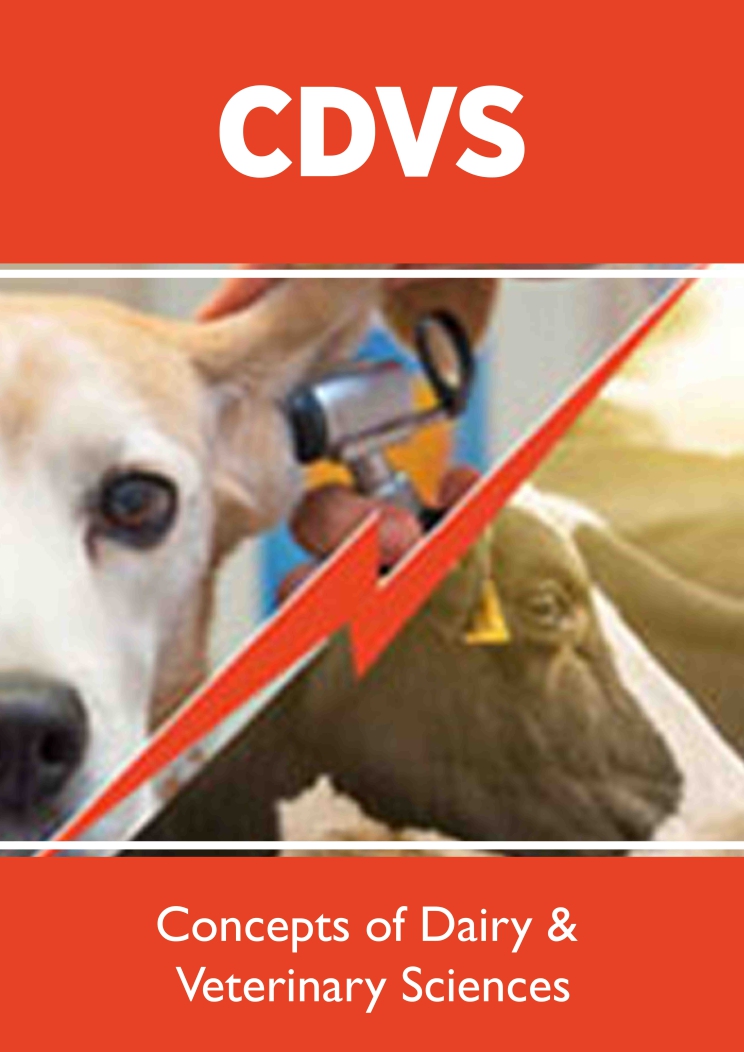-
Review ArticleView abstract
 PDF
PDF
 Full text
The intramammary infusion of an antibiotic to all quarters of all cows after the last milking of the lactation or Blanket Dry Cow Therapy (BDCT) - has long been recommended for the treatment of present subclinical mastitis and prevention of new Intramammary Infection (IMI) [1], [2]. However, there has been a dramatic change in the incidence and etiology of clinical and sub-clinical mastitis, reflected in a decrease in the prevalence of contagious mastitis pathogens and an increase in the importance of the environmental pathogens such as S. uberis and E. coli [3]. Estimates show that 35% to 50% of udder quarters are pathogen-free at drying off [4], [5]. Coinciding with this, the EU Regulation 2019/6 is to prohibit the preventive use of antibiotics in food-producing animals...... ReadMore
Full text
The intramammary infusion of an antibiotic to all quarters of all cows after the last milking of the lactation or Blanket Dry Cow Therapy (BDCT) - has long been recommended for the treatment of present subclinical mastitis and prevention of new Intramammary Infection (IMI) [1], [2]. However, there has been a dramatic change in the incidence and etiology of clinical and sub-clinical mastitis, reflected in a decrease in the prevalence of contagious mastitis pathogens and an increase in the importance of the environmental pathogens such as S. uberis and E. coli [3]. Estimates show that 35% to 50% of udder quarters are pathogen-free at drying off [4], [5]. Coinciding with this, the EU Regulation 2019/6 is to prohibit the preventive use of antibiotics in food-producing animals...... ReadMore -
Short CommunicationView abstract
 PDF
PDF
 Full text
The biological properties of CLA are attracting the scientific community, because of its wide range of health benefits, particularly anti-carcinogenic, anti-atherosclerosis, and anti-obesity [1], anti-diabetic [2] and enhancement of immunity properties [3], demonstrated “in vivo” studies using different animal models. High quality raw milk, from Azorean lactating Holstein cows (the same breed) grazing pasture (fresh grass) during all seasons, donated by Unlimited Milk Plant, were collected in sterilized flasks, refrigerated at 4 °C and after fat adjustment (1.5% - half-skymmed) were stored at -20 °C. The commercial pasteurized and ultra pasteurized (UHT) half-skymmed (the most consumed in the Azores Islands) samples, obtained from local stores, were taken in triplicate from cows of different ages, in several lactating phases, and ob..... ReadMore
Full text
The biological properties of CLA are attracting the scientific community, because of its wide range of health benefits, particularly anti-carcinogenic, anti-atherosclerosis, and anti-obesity [1], anti-diabetic [2] and enhancement of immunity properties [3], demonstrated “in vivo” studies using different animal models. High quality raw milk, from Azorean lactating Holstein cows (the same breed) grazing pasture (fresh grass) during all seasons, donated by Unlimited Milk Plant, were collected in sterilized flasks, refrigerated at 4 °C and after fat adjustment (1.5% - half-skymmed) were stored at -20 °C. The commercial pasteurized and ultra pasteurized (UHT) half-skymmed (the most consumed in the Azores Islands) samples, obtained from local stores, were taken in triplicate from cows of different ages, in several lactating phases, and ob..... ReadMore -
Research ArticleView abstract
 PDF
PDF
 Full text
Postpartum diseases impact the overall efficiency of lactating dairy cows [1]. Vaccination strategies have been explored to prevent or reduce incidence of specific postpartum disorders [2- 4]. Intranasal vaccines for aid in prevention of bovine respiratory disease (BRD) have been recently investigated as a potential strategy to reduce negative postpartum health outcomes in dairy cows [5]. Although BRD is uncommonly the most prevalent disease after calving [6], cows diagnosed with pneumonia are expected to have increased mortality and morbidity. Therefore, minimizing the incidence of BRD after calving on dairy farms is desirable. Most research studies evaluating efficacy and mechanism of action of administering modified-live virus (MLV) intranasal vaccines were conducted with calves [7-9]. Reports have shown that intranasal vaccines modula..... ReadMore
Full text
Postpartum diseases impact the overall efficiency of lactating dairy cows [1]. Vaccination strategies have been explored to prevent or reduce incidence of specific postpartum disorders [2- 4]. Intranasal vaccines for aid in prevention of bovine respiratory disease (BRD) have been recently investigated as a potential strategy to reduce negative postpartum health outcomes in dairy cows [5]. Although BRD is uncommonly the most prevalent disease after calving [6], cows diagnosed with pneumonia are expected to have increased mortality and morbidity. Therefore, minimizing the incidence of BRD after calving on dairy farms is desirable. Most research studies evaluating efficacy and mechanism of action of administering modified-live virus (MLV) intranasal vaccines were conducted with calves [7-9]. Reports have shown that intranasal vaccines modula..... ReadMore -
Research ArticleView abstract
 PDF
PDF
 Full text
Embryo transfer is an enabling ART offering vital solutions for various reproductive challenges. Its application is utilized in multiple species, benefiting not only animals but also humans facing infertility. Since its introduction into routine cattle practice in the 1970s, embryo transfer has evolved significantly, providing continuous support for dairy producers [1]. Both super ovulation and in vitro embryo production offer tools to meet producer’s specific goals and challenges. The number of in vitro produced embryos transferred and reported to the International Embryo Technologies Society (IETS) surpassed in vivo derived embryos transferred around 2016 [2]. Both technologies enhance the accuracy of genetic selection, intensify dam-side genetic selection, enable genomic selection at the embryo stage, and facilitate the production of..... ReadMore
Full text
Embryo transfer is an enabling ART offering vital solutions for various reproductive challenges. Its application is utilized in multiple species, benefiting not only animals but also humans facing infertility. Since its introduction into routine cattle practice in the 1970s, embryo transfer has evolved significantly, providing continuous support for dairy producers [1]. Both super ovulation and in vitro embryo production offer tools to meet producer’s specific goals and challenges. The number of in vitro produced embryos transferred and reported to the International Embryo Technologies Society (IETS) surpassed in vivo derived embryos transferred around 2016 [2]. Both technologies enhance the accuracy of genetic selection, intensify dam-side genetic selection, enable genomic selection at the embryo stage, and facilitate the production of..... ReadMore -
Review ArticleView abstract
 PDF
PDF
 Full text
Food aroma is a sensory property produced by the interaction between chemical compounds and sensory receptors and, particularly, cheese aroma consumer perception is one of the foremost criteria for its preference and acceptance. Head-space solid phase microextraction gas chromatography (HS-SPME/GC) is commonly used for qualitative and quantitative analysis of volatile compounds..... ReadMore
Full text
Food aroma is a sensory property produced by the interaction between chemical compounds and sensory receptors and, particularly, cheese aroma consumer perception is one of the foremost criteria for its preference and acceptance. Head-space solid phase microextraction gas chromatography (HS-SPME/GC) is commonly used for qualitative and quantitative analysis of volatile compounds..... ReadMore -
Research ArticleView abstract
 PDF
PDF
 Full text
In Arizona, where high temperatures (>32°C) are typical, there are limited data on horse behavior, activity, and voluntary use of shade structures to block solar radiation as temperatures rise. This study aimed to examine if increasing Temperature Humidity Index (THI)...... ReadMore
Full text
In Arizona, where high temperatures (>32°C) are typical, there are limited data on horse behavior, activity, and voluntary use of shade structures to block solar radiation as temperatures rise. This study aimed to examine if increasing Temperature Humidity Index (THI)...... ReadMore -
Mini ReviewView abstract
 PDF
PDF
 Full text
Traditionally narrow disciplinary silos appear to have furthered consolidation and industrialization of dairy farms as Concentrated Agricultural Feeding Operations or CAFOs reliant on monoculture farming of feed grains, typically with synthetic fertilizers and pesticides...... ReadMore
Full text
Traditionally narrow disciplinary silos appear to have furthered consolidation and industrialization of dairy farms as Concentrated Agricultural Feeding Operations or CAFOs reliant on monoculture farming of feed grains, typically with synthetic fertilizers and pesticides...... ReadMore -
Research ArticleView abstract
 PDF
PDF
 Full text
Based on multi-variable calculations, it was established that the light-trap catch of the examined 7 caddisfly species is primarily influenced by the Sun, out of the 27 environmental factors taken into account. The Moon and the weather also have a smaller but significant influence. The influence of other factors is less important than these ones...... ReadMore
Full text
Based on multi-variable calculations, it was established that the light-trap catch of the examined 7 caddisfly species is primarily influenced by the Sun, out of the 27 environmental factors taken into account. The Moon and the weather also have a smaller but significant influence. The influence of other factors is less important than these ones...... ReadMore
Lupine Publishers Group
Lupine Publishers
ISSN: 2637-4749
Concepts of Dairy & Veterinary Sciences
Concepts of Dairy & Veterinary Sciences (CDVS) is an international journal established for the harvesting of animal milk – mostly from cows or goats, but also from buffaloes, sheep, horses or camels – for human consumption. A dairy is typically located on a dedicated dairy farm or in a section of a multi-purpose farm that is concerned with the harvesting of milk. Dairy Research is the field that deals with the Dairy and animal breeding, Physiology, Cell biology and endocrinology of lactation, animal science, milk production and composition, Biotechnology and food technology, properties of milk proteins and other components, dairy products such as cheese, fermented milks and spreads, relevant studies in bacteriology, enzymology and immunology, the use of milk products in other foods, and the development of methods related to Dairy Science. Dairy and Veterinary Science is a quarterly, open access, peer-reviewed journal aims to publish submissions/articles on current concepts in the field of veterinary, animal studies including animal nutrition, veterinary science physiology, veterinary medicine and behaviour, diagnosis, treatment and prevention among animal diseases including wild, domestic and avian, animal rehabilitation, animal therapy, animal care, animal physiotherapy, arthrography, Bovine Milk, Dairy Cows, Dairy Diseases, Dairy Farm, Health and Dairy Products, Homogenized Milk, Milk Born Diseases, Pasteurization, Skimmed Milk related to dairy science, etc.



















.png)
.jpg)

